Castilleja coccinea, scarlet indian paintbrush, is an native annual/biennial herbaceous plant and is rare in NJ. It is almost the only species of paintbrush (Castilleja) in the east. There are many species in the western states. It is also known as painted-cup paintbrush or eastern paintbrush.
Flowers
Inflorescence/Flower cluster:
Castilleja coccinea, scarlet paintbrush, blooms in spring. It has compact flower clusters that develop at the top a stem with a few indiviual flowers along the stem. The flower head can easily be 3 inches by 2 inches. The Inflorescence becomes longer as the flowers mature.


A closer look at the flower head:
It is the colorful bright red bracts, not petals, that give this plant its showiness. There is a form that has yellow bracts, f. lutescens.
The flowers are somewhat inconspicuous between the bracts.
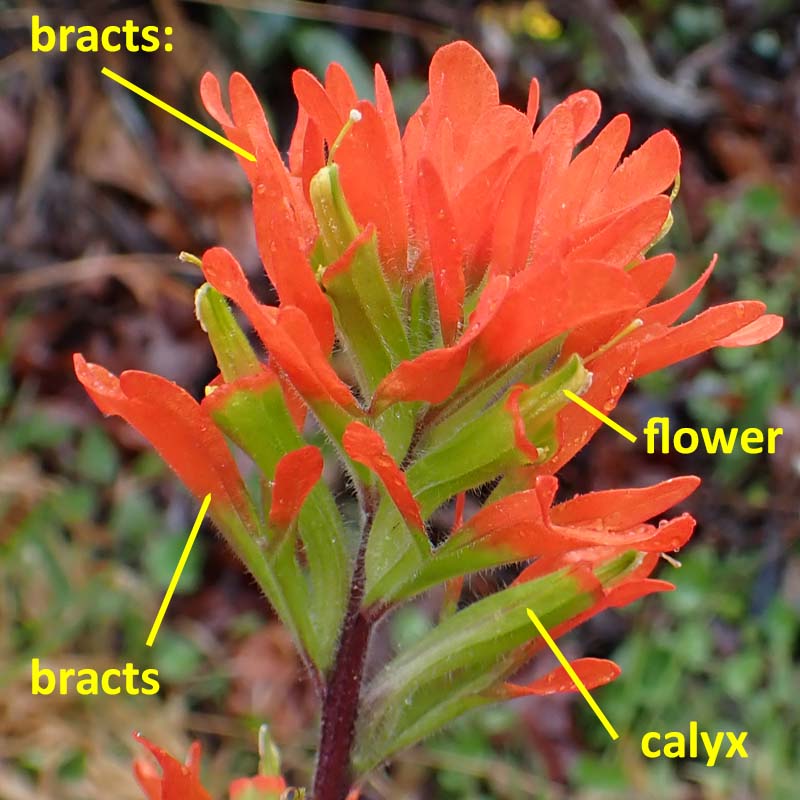
Flowers and bracts:
The solitary flowers form at the axils of the bracts.
The red bracts are modified leaves. The bracts are mainly 3 lobed but sometimes 5 lobed with variable shapes. The upper bracts are more deeply cut and more colorful and frequently colored throughout. Bracts are mostly green at the base. This gives the plant the look of a brush dipped into red paint. The lower bracts are more leafy.
Lower bract beneath a flower:

Flower at the axil with a bract: yellow pointers - bract lobes, blue pointer - calyx. The calyx is green except for the far edge of the calyx which is red.
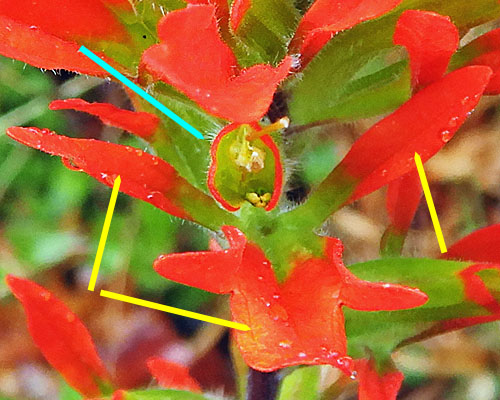
The calyxes are tubular, up to an inch long, are green and mostly with red tips. The calyxes are two lobed.
Inside the calyx, is the corolla which is tubular and extends beyond the calyx. The corolla has 2 fused petals, upper lip called the galea and a lower lip that is much shorter. The corolla is green or yellow or whitish. The lower lip is very small and has 3 teeth that can be yellow, white, or pinkish. The left photo below also shows the 3 yellow teeth of the lower lip.
The flower has a single style/stigma that extends beyond the corolla and a green ovary in the corolla. It has 2 pairs stamens.
At the bottom of the floral tube is nectar which is accessed by hummingbirds and other insects that can reach the end of the tube and pollinate the plant.
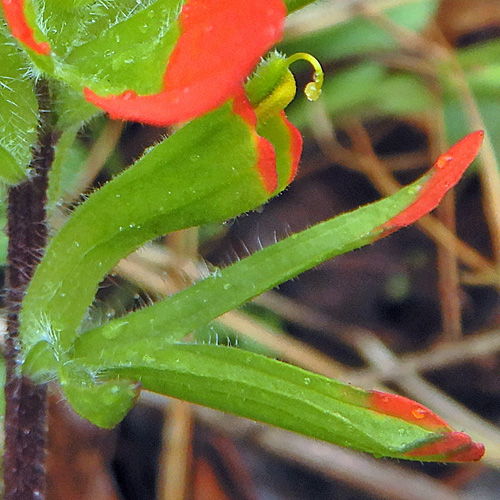

Plant - Leaves - Rarity
The C. coccinea plant is usually biennial but sometimes annual. The seeds usually germinate the next spring and produce basal leaves. The next year, the plant will send up a single or a few upright hairy purple stalks with flowers that are usually unbranched. The plant can be about 2 ft tall.
Leaves: Scarlet paintbrush has both basal leaves and cauline leaves. Basal rosette leaves can be persistent at flowering and are about 4 inches long and 1 inch wide and usually not lobed. In the photo below they are purplish like the stems.
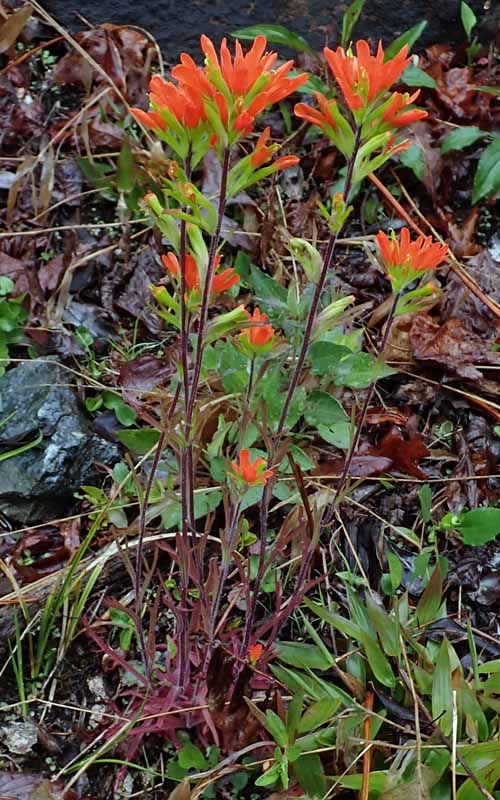
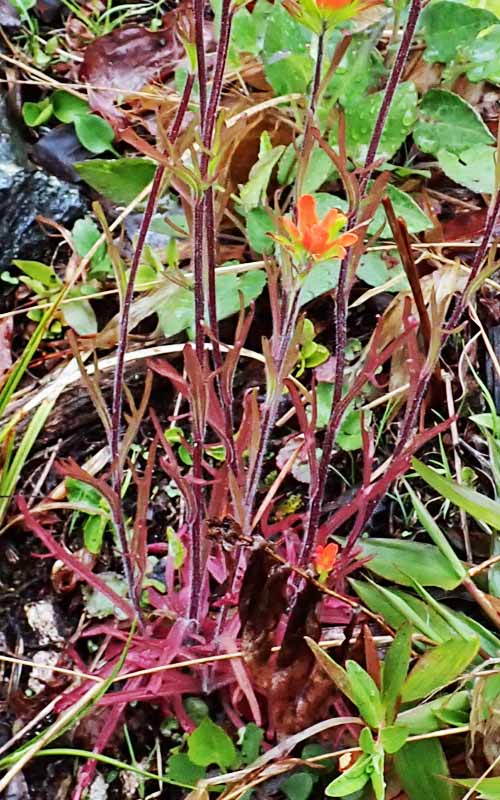
The cauline (stem) leaves are up to 3 inches long, alternate, sessile, and deeply divided into 3 lobes. Sometimes the leaves have more lobes and are variably shaped. The leaves become shorter up the stem. They are greenish or reddish brown.
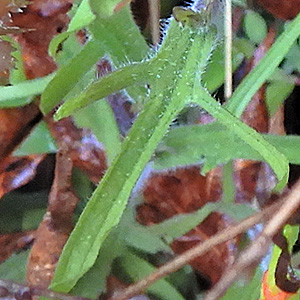

C. coccinea plant is hemiparasitic. Hemiparasitic plants have green leaves and photosynthesize, but in addition they rely on the ability to obtain nutrients from other plants. This is done by attaching to the roots of the host plants with structures called haustoria. The scarlet paintbrush is parasitic on host plants and decreases the host plant's vitality. Scarlet paintbrush can attach to a wide variety of plants. The seeds are very small so that in the early stages of life the plant is completely parasitic on other plants.
Rarity: In 2023, NatureServe reports Castilleja coccinea in NJ as 'S1'. 'S1' means "Critically imperiled in New Jersey because of extreme rarity (5 or fewer occurrences or very few remaining individuals or acres)." USDA shows that in the past, the paintbrush was present in almost every county of NJ! In iNaturalist, 2023, there are no observations of C. coccinea in NJ for any time.
In the US, NatureServe, the reporting states have rarities of S3(Vulnerable) to SX(Presumed Extirpated)! It is not an easy plant to find in the wild. There are only 2 species in the east, C. coccinea and C. septentrionalis which is only up in the extreme Northeast (BONAP Click here)
We were fortunate to attend the 2023 Joint Field Meeting of the: Botanical Society of America Northeastern Section, Torrey Botanical Society, & Philadelphia Botanical Club in April in the mountains of western North Carolina. Seeing the scarlet indian paintbrushes was a treat. In NC, the rarity is S3. BONAP shows where it is currently present (Click here)

Text by Millie Ling and all photos by Hubert & Millie Ling. Photos: April 2023, mountains of western North Carolina.
Additional information
Additional information / references:
- Missouriplants.com - good description and photos: https://www.missouriplants.com/Castilleja_coccinea_page.html target
- USDA plant of the week - nice summary: https://www.fs.usda.gov/wildflowers/plant-of-the-week/Castilleja-coccinea.shtml
- NJDEP plant profile, status in NJ: https://www.nj.gov/dep/njnlt/profiles/castilleja-coccinea-indian-paintbrush.pdf
- Phytoimages - image of the flower itself corolla - upper and lower, pistil, and stamen: http://phytoimages.siu.edu/imgs/paraman1/r/Orobanchaceae_Castilleja_coccinea_105811.html
- The USDA website shows Castilleja coccinea county distribution NJ as well in the US and other information: https://plants.sc.egov.usda.gov/home/plantProfile?symbol=CACO17
- The Explorer at NatureServe shows Castilleja coccinea distribution and rarity in the US and other information: https://explorer.natureserve.org/Taxon/ELEMENT_GLOBAL.2.135078/Castilleja_coccinea.